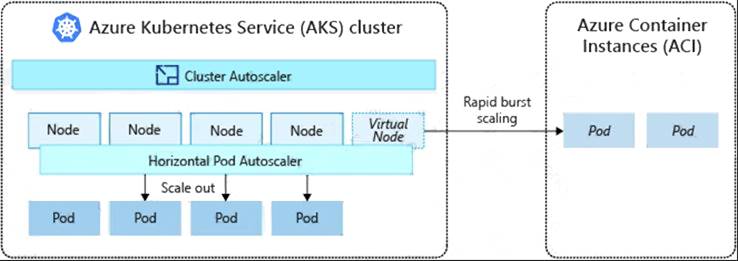- (Exam Topic 5)
You have an on-premises network and an Azure subscription. The on-premises network has several branch offices.
A branch office in Toronto contains a virtual machine named VM1 that is configured as a file server. Users access the shared files on VM1 from all the offices.
You need to recommend a solution to ensure that the users can access the shares files as quickly as possible if
the Toronto branch office is inaccessible.
What should you include in the recommendation?
Correct Answer:
B
Use Azure File Sync to centralize your organization's file shares in Azure Files, while keeping the flexibility, performance, and compatibility of an on-premises file server. Azure File Sync transforms Windows Server into a quick cache of your Azure file share.
You need an Azure file share in the same region that you want to deploy Azure File Sync. Reference:
https://docs.microsoft.com/en-us/azure/storage/files/storage-sync-files-deployment-guide
- (Exam Topic 5)
You have an Azure subscription. The subscription has a blob container that contains multiple blobs. Ten users in the finance department of your company plan to access the blobs during the month of April. You need to recommend a solution to enable access to the blobs during the month of April only. Which security solution should you include in the recommendation?
Correct Answer:
A
Reference:
https://docs.microsoft.com/en-us/azure/storage/common/storage-sas-overview
- (Exam Topic 5)
You have an on-premises application named App1 that uses an Oracle database.
You plan to use Azure Databricks to transform and load data from App1 to an Azure Synapse Analytics
instance.
You need to ensure that the App1 data is available to Databricks.
Which two Azure services should you include in the solution? Each correct answer presents part of the solution.
NOTE: Each correct selection is worth one point.
Correct Answer:
CE
- (Exam Topic 5)
You have an Azure subscription.
You need to deploy an Azure Kubernetes Service (AKS) solution that will use Windows Server 2019 nodes.
The solution must meet the following requirements:
Minimize the time it takes to provision compute resources during scale-out operations. Support autoscaling of Windows Server containers.
Which scaling option should you recommend?
Correct Answer:
D
Azure Container Instances (ACI) lets you quickly deploy container instances without additional infrastructure overhead. When you connect with AKS, ACI becomes a secured, logical extension of your AKS cluster. The virtual nodes component, which is based on Virtual Kubelet, is installed in your AKS cluster that presents ACI as a virtual Kubernetes node. Kubernetes can then schedule pods that run as ACI instances through virtual nodes, not as pods on VM nodes directly in your AKS cluster.
Your application requires no modification to use virtual nodes. Deployments can scale across AKS and ACI and with no delay as cluster autoscaler deploys new nodes in your AKS cluster.
Diagram Description automatically generated
Note: AKS clusters can scale in one of two ways: The cluster autoscaler watches for pods that can't be scheduled on nodes because of resource constraints.
The cluster autoscaler watches for pods that can't be scheduled on nodes because of resource constraints.
The cluster then automatically increases the number of nodes. The horizontal pod autoscaler uses the Metrics Server in a Kubernetes cluster to monitor the resource demand of pods. If an application needs more resources, the number of pods is automatically increased to meet the demand.
The horizontal pod autoscaler uses the Metrics Server in a Kubernetes cluster to monitor the resource demand of pods. If an application needs more resources, the number of pods is automatically increased to meet the demand.
Reference:
https://docs.microsoft.com/en-us/azure/aks/concepts-scale5
- (Exam Topic 5)
You plan to migrate data to Azure.
The IT department at your company identifies the following requirements:  The storage must support 1 PB of data.
The storage must support 1 PB of data. The data must be stored in blob storage.
The data must be stored in blob storage. The storage must support three levels of subfolders.
The storage must support three levels of subfolders.  The storage must support access control lists (ACLs).
The storage must support access control lists (ACLs).
You need to meet the requirements. What should you use?
Correct Answer:
B
Microsoft recommends that you use a GPv2 storage account for most scenarios. It supports up to 5 PB, and blob storage including Data Lake storage.
Note: A key mechanism that allows Azure Data Lake Storage Gen2 to provide file system performance at object storage scale and prices is the addition of a hierarchical namespace. This allows the collection of objects/files within an account to be organized into a hierarchy of directories and nested subdirectories in the same way that the file system on your computer is organized. With a hierarchical namespace enabled, a storage account becomes capable of providing the scalability and cost-effectiveness of object storage, with file system semantics that are familiar to analytics engines and frameworks.
References:
https://docs.microsoft.com/en-us/azure/storage/common/storage-account-overview https://docs.microsoft.com/en-us/azure/storage/blobs/data-lake-storage-namespace